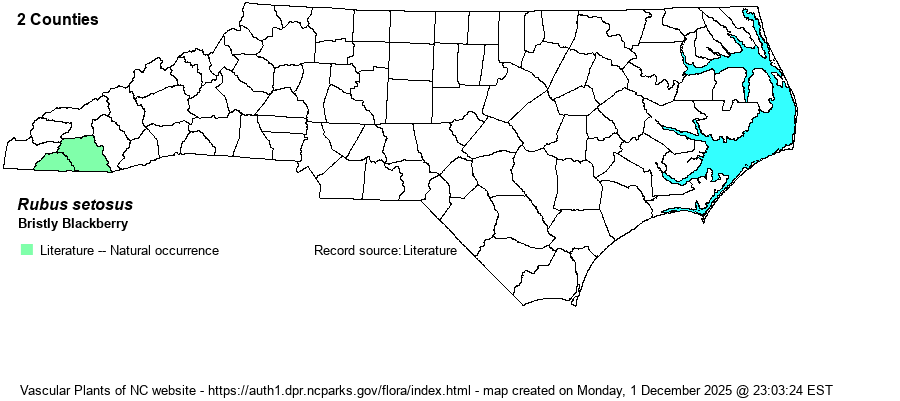| Author | Bigelow | |
| Distribution | If correctly identified, there are records only from Macon and Clay counties (on the BONAP map and on the NCNHP Rare List [2018]) -– both in the southern Mountains. However, there appear to be no specimens known -- the SERNEC portal does not list any such collections. Also, Weakley (2024) does not list the species for NC, other than a "?" for the Mountains.
This is a northern species, mostly in Canada and New England; ranges very sparsely south to northwestern VA and IL, and disjunct to NC -– if these are indeed correctly identified. VA now has two county records. | |
| Abundance | Extremely rare in NC, and highly disjunct southward from north-central VA; plus, there are no records for KY or TN. Though this species is on the NC Watch List, if correctly identified the species should be moved to the Significantly Rare list owing to extreme rarity and southern disjunction. | |
| Habitat | This is one of the few wetland species of blackberries in the state, being found in wet thickets, montane swamps, and bogs. However, in the northern states it can occur in upland habitats – as long as they are sunny and mainly non-forested. | |
| Phenology | Flowers in June and July; fruits in August and September. | |
| Identification | This is a very low deciduous shrub, typically 1-3 feet tall, with long and often arching stems. It should be fairly easily identified by it low stature -– in-between the trailing habitat of R. flagellaris and R. hispidus and the erect and taller stature of R. argutus/pensilvanicus, and by its hundreds to thousands of slender bristles all along the stems, though the bristles are flexible and not overly prickly or sharp to the touch. In addition, it grows in our area only in wetland habitats. This is a very poorly known species in the mid-Atlantic region, as it occurs essentially only north of the area. It is likely that almost no state biologists are familiar with it in the mid-Atlantic states, and thus it could be overlooked, especially as many are not likely to pay attention to a blackberry! | |
| Taxonomic Comments | There are many old synonyms for this species, as there are for many Rubus species. There are apparently no varieties.
| |
| Other Common Name(s) | Setose Blackberry is now in wide usage (such as by the USDA); Small Bristleberry | |
| State Rank | S1? | |
| Global Rank | G5 | |
| State Status | W7 | |
| US Status | | |
| USACE-agcp | | |
| USACE-emp | | |

